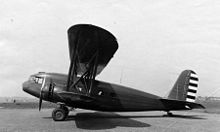
The Curtiss T-32 Condor
Written by Robert G. Waldvogel
The Curtiss Aeroplane and Motor Company, reflecting the name of its founder, Glenn Hammond Curtiss, produced a handful of passenger-carrying transports on Long Island, after it established a research and development facility there in 1918. One of them was the Condor.
Its two major versions represented transitional technology, serving as bridges between the bi-plane and monoplane airliner (examples of the latter including the Boeing 247 and the Douglas DC-2).
“In most respects, (the Condor) was a step backwards in aircraft design—a twin-engine biplane whose forest of struts and wires provided built-in headwinds,” according to Robert J. Serling in Eagle: The Story of American Airlines (New York: St. Martin’s/Marek, 1985, p. 55).

In the early 1930’s Eastern Air Transport (later Eastern Air Lines) was expanding. This expansion included the acquisitions of New York Airways in 1931, along with its Atlantic City route, and Ludington Air Lines two years later, in 1933, with its own New York-Washington route authority. Eastern inaugurated a New York-Miami through-service with the very first Model 18 Condor to see commercial service on January 7, 1933. Differing from the later Model 32, it featured twin vertical stabilizers. Eastern used it to funnel winter-weary passengers to Florida’s sunbaked beaches. The Model 18 was also operated by National Air Transport.
Although the new type was slow and lumbering it was considered the first sleeper transport, whose comfort emulated the railroad’s Pullman berths, a necessity on stretches that required the morning set of the alarm to reach throughout the night.

Advancement occurred on many levels in the later Model 32 of 1933. The 32 was powered by two 710-hp, nine-cylinder Wright SCR-1820-F3 radials that turned three-bladed, variable-pitch propellers. This reduced the noise and vibration that otherwise propagated through the cabin like a tuning fork. The Condor II, as it was also known, was the result of frame-and-fabric construction, had a 49.6-foot length (actually shorter than its Condor I predecessor), and an 82-foot wingspan built with a tubular spar. Only a single vertical and horizontal tailplane was employed.
Drag reduction, attempting to compensate for that generated by the wing struts, was to some degree achieved with a retractable undercarriage.

Accommodation in a cabin blanketed with 70 pounds of soundproofing material was for 15 day or 12 night-berth passengers, who were attended to by a single “stewardess.”
First flying on January 30, 1933, the 32 had a 17,500-pound gross weight, an 840-mile range, and a 22,000-foot service ceiling.

American Airlines, which placed a $500,000 order for ten model 32’s, placed them into sleeper service between Ft. Worth and Los Angeles, which constituted a portion of its transcontinental route, on May 5, 1934, offering a competitive advantage over TWA and United. Neither of these competitors could not offer comparable comfort with their existing equipment. The 32 was also used to increase AAL’s daily round trip frequencies between New York and Chicago in September, advertising in its June 15, 1934 system timetable, “The world’s first complete sleeper planes.” One such route included Dallas, Ft. Worth, Abilene, Big Spring, and El Paso in Texas, Douglas, Tucson, and Phoenix in Arizona, and Los Angeles in California.
While The Condor Model 32 rarely achieved its 145-mph maximum speed and had a penchant for icing, it was otherwise popular.

Passengers loved the Condor’s roomy cabin,” according to Serling (ibid, p. 56). “In American’s configuration, the big biplane carried 18 passengers by day and could accommodate 14 in the surprisingly spacious berths. Compared to the noisy, rattling Fords and cramped Stinsons and Vultees, the Condor interior was palatial and compensated for the airliner’s abysmal performance.”
Of the 45 produced, not an insignificant quantity for their time, wore the colors of Swissair in Europe and Avianca and LAN-Chile in South America. They also served in military roles with the Army Air Corps, the Navy, and the Marines in the US, and with the air forces of China, Colombia, Honduras, and Peru, among others.
Curtiss T-32 Condor Images
Wiki Commons
Trackback from your site.


Antonin Alfery
| #
Dear Mr.Waldvogel,
I am looking for a color scheme or description for AT32C aircraft used by Swissair (CH-170, HB-LAP)
Can you give me any advice?
Thank you.
Sincerely
Antonín Alfery, Czech Republic
Reply
Andrew Wood
| #
https://sr692.com/fleet/08_curtiss/index.html
Try the website above for basic details.
Reply
Ronald P Barnes
| #
Isn’t the sole remaining Condor II being rebuilt in Utah by a retired AA Captain? This one crashed in the Catskill Mtns of NY. Then trained to Glenview IL for storage for 60 yrs. Anyone have anymore data?
Reply
Jeri Barrientos
| #
Any way to help secure plans for the Curtiss T-32 Condor II? My team in Collinsville, OK is prepared to start the feasibility study once the plans are secure. Any insight or assistance will be greatly appreciated!
Reply
John Danner
| #
I notice that in your finely written article regarding the T-32, you make no mention of the type also being operated by Swissair. Nelly Diener was their stewardess on the Condor and she was the first flight attendant for an airline in Europe. I enjoyed reading your article.
Reply
Robert Waldvogel
| #
In order to remain within the historical society’s length limitations, any articles I post necessarily must be short, obviously omitting many, many details. I wish I had more space. Nevertheless, thank you for your kind comments.
Reply